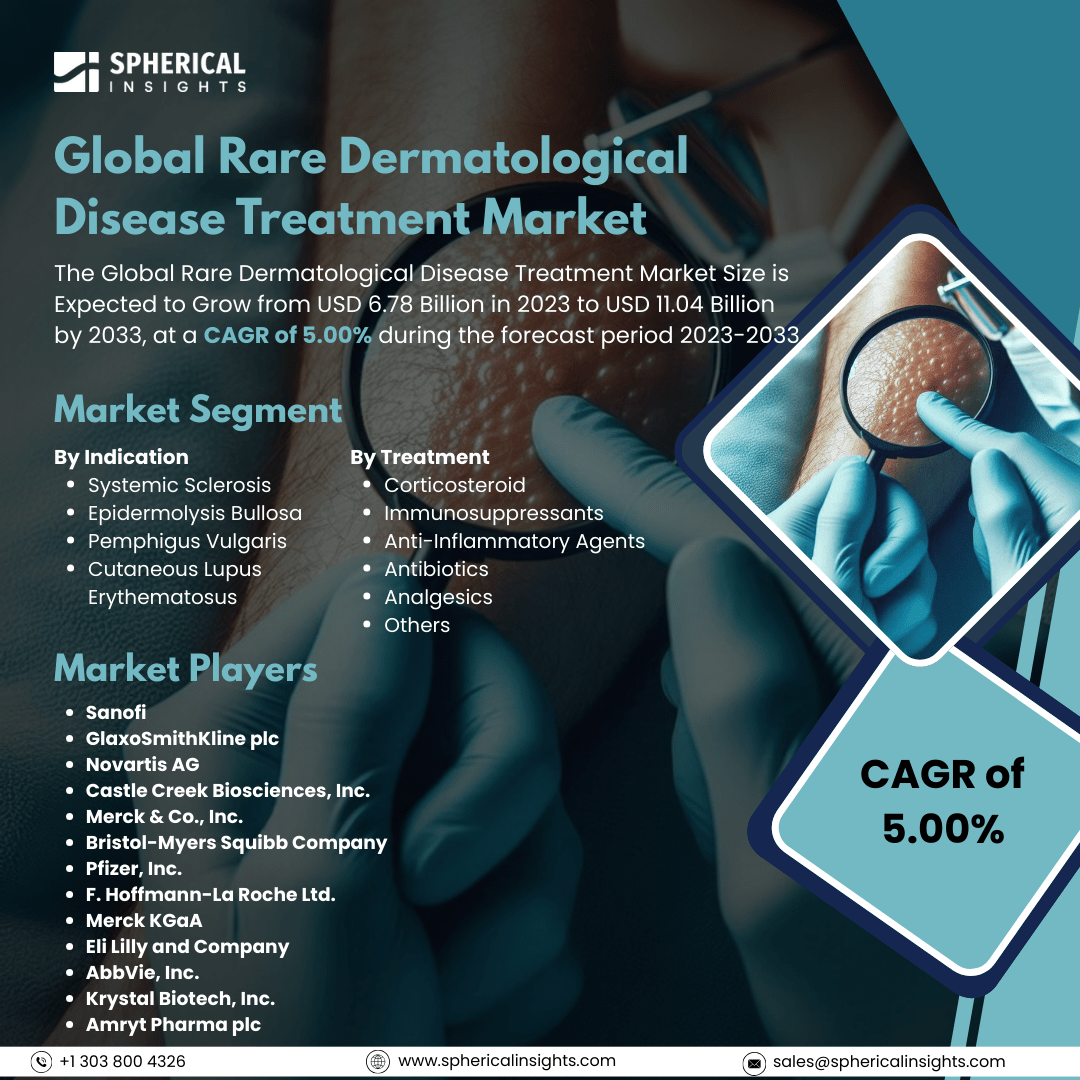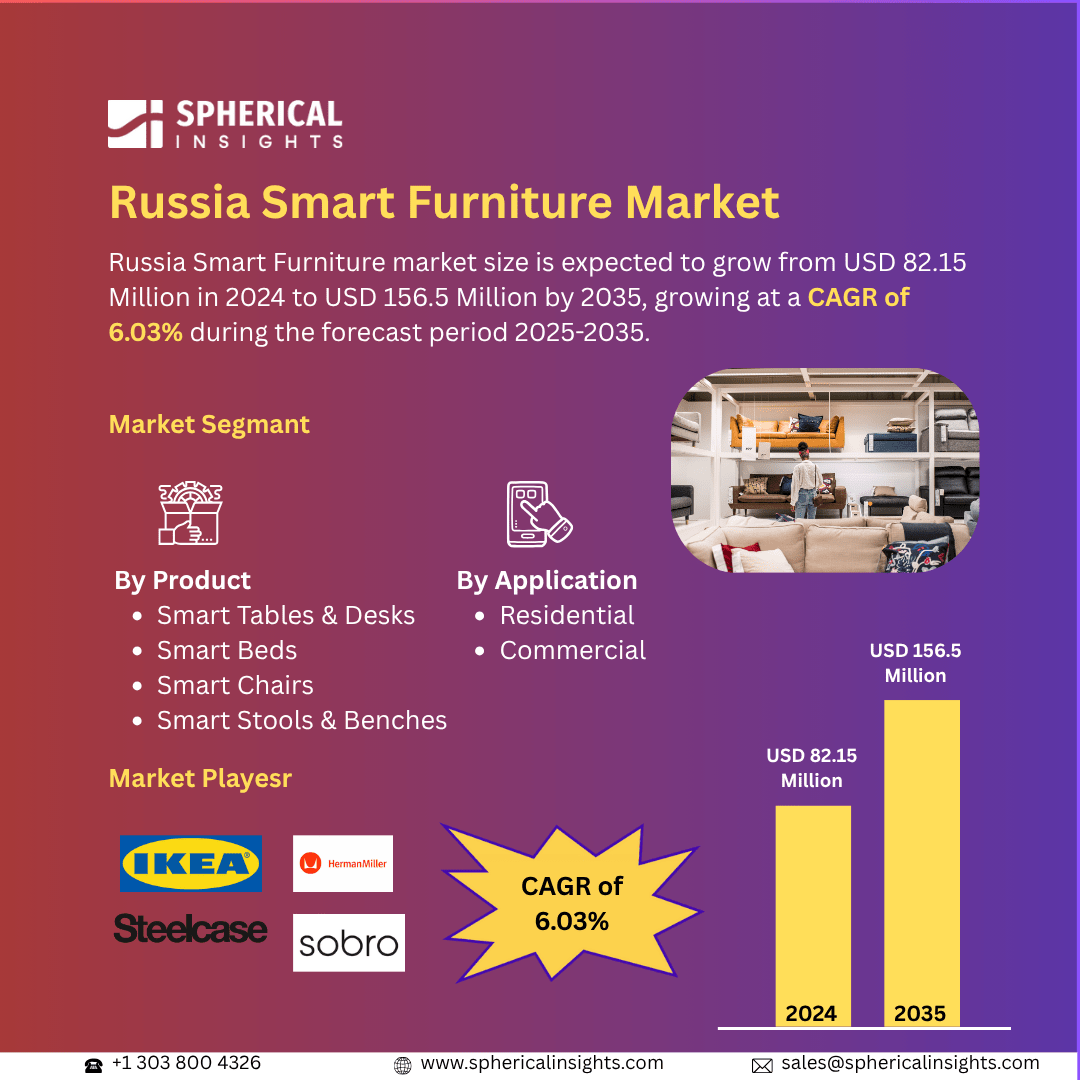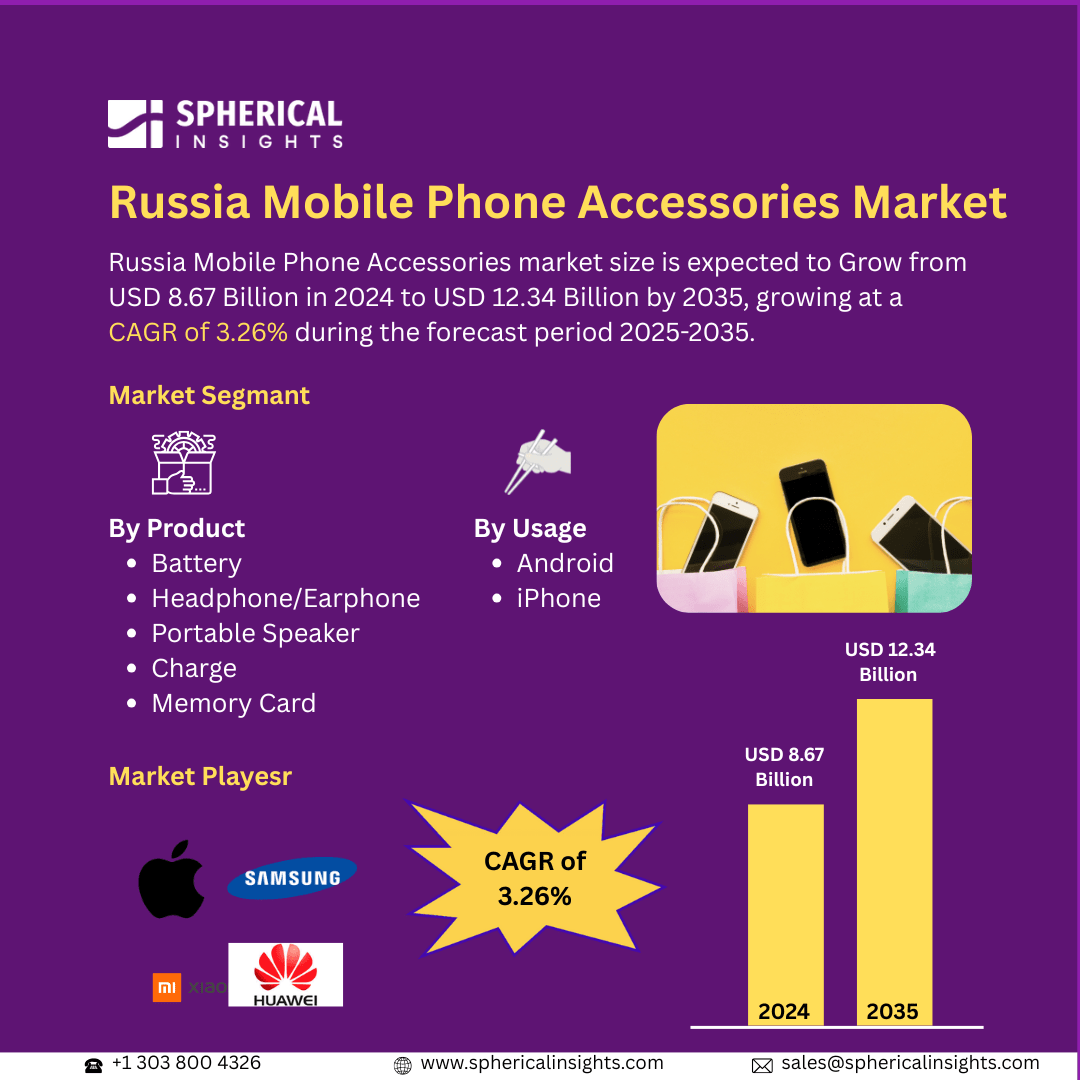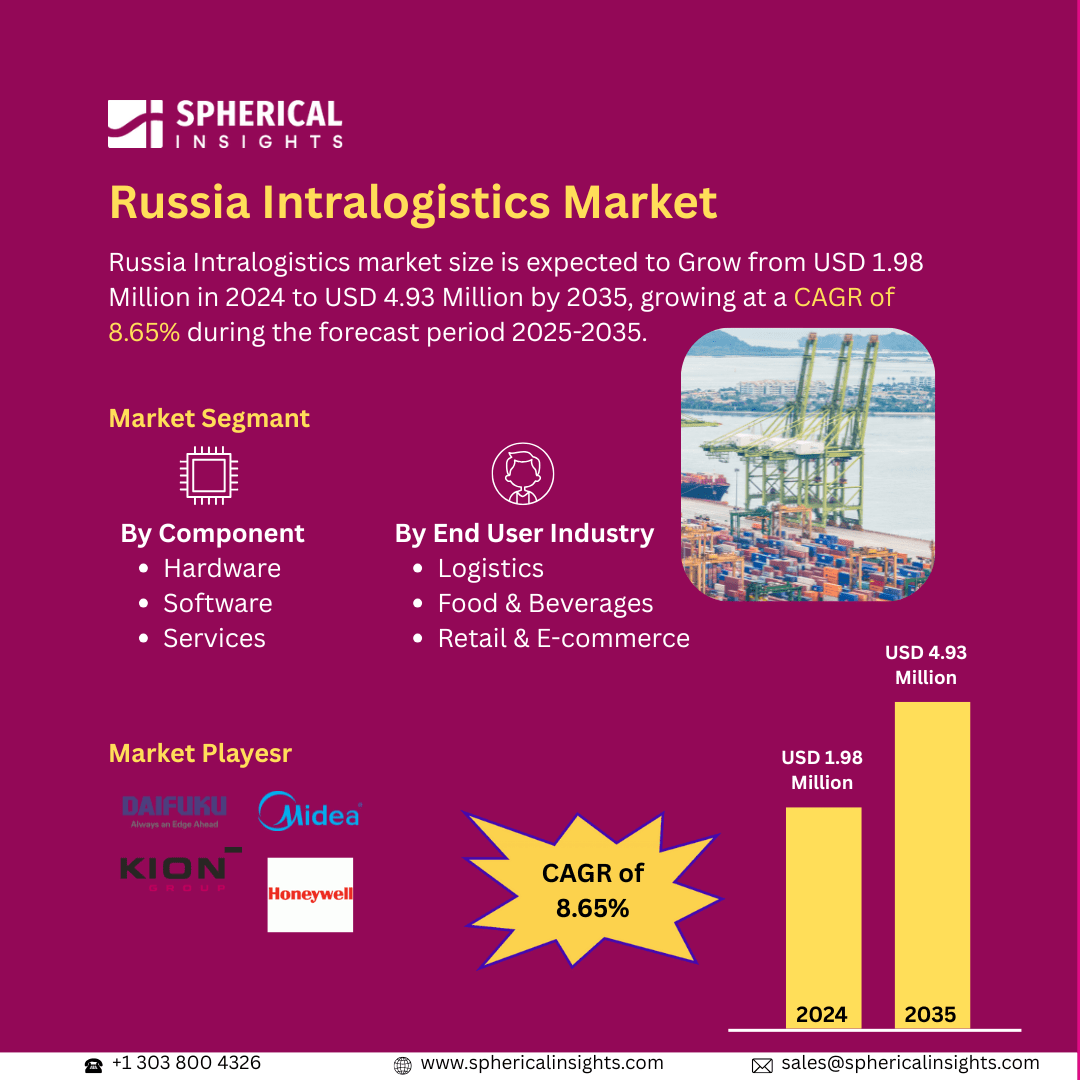Global Rare Dermatological Disease Treatment Market Size to Exceed USD 11.04 Billion by 2033
According to a research report published by Spherical Insights & Consulting, The Global Rare Dermatological Disease Treatment Market Size is Expected to Grow from USD 6.78 Billion in 2023 to USD 11.04 Billion by 2033, at a CAGR of 5.00% during the forecast period 2023-2033.
Browse 210 market data Tables and 45 Figures spread through 190 Pages and in-depth TOC on the Global Rare Dermatological Disease Treatment Market Size, Share, and COVID-19 Impact Analysis, By Indication (Systemic Sclerosis, Epidermolysis Bullosa, Pemphigus Vulgaris, and Cutaneous Lupus Erythematosus), By Treatment (Corticosteroid, Immunosuppressants, Anti-Inflammatory Agents, Antibiotics, Analgesics, and Others), By Distribution Channel (Hospital Pharmacies, Retail Pharmacies, and Online Pharmacies), and By Region (North America, Europe, Asia-Pacific, Latin America, Middle East, and Africa), Analysis and Forecast 2023 – 2033.
The market for rare dermatological disease treatment is the international industry engaged in the diagnosis, treatment, and care of rare skin diseases that occur in a small percentage of the population. Pharmaceutical drugs, biologics, gene therapies, and novel treatment approaches are included in this market intended for diseases like epidermolysis bullosa, pemphigus, xeroderma pigmentosum, and other rare dermatological conditions. It is propelled by research advancements, rising awareness, regulatory benefits, and the expanding supply of targeted therapies. Furthermore, the key growth drivers of the market for the treatment of global rare dermatological disease are growing incidences of rare skin conditions, advancements in biotechnology and dermatology, and increasing research and development expenditures. Enhanced awareness, better diagnostic features, favorable government policies, and increasing availability of targeted treatments fuel market expansion. Furthermore, adequate patient advocacy also improves treatment options and innovation. However, the high treatment costs, limited awareness, delayed diagnosis, lack of specialized healthcare facilities, stringent regulatory approvals, and limited availability of effective therapies are key restraints for the growth of the market.
The systemic sclerosis segment accounted for the largest share in 2023 and is anticipated to grow at a significant CAGR during the forecast period.
On the basis of the indication, the global rare dermatological disease treatment market is divided into systemic sclerosis, epidermolysis bullosa, pemphigus vulgaris, and cutaneous lupus erythematosus. Among these, the systemic sclerosis segment accounted for the largest share in 2023 and is anticipated to grow at a significant CAGR during the forecast period. The segmental growth is attributed to its increasing prevalence, rising awareness, and advancements in targeted therapies. Improved diagnostic techniques, growing research initiatives, and a higher demand for effective treatment options further drive its significant CAGR growth during the forecast period. Additionally, increased healthcare investments support market expansion.
The corticosteroid segment accounted for the largest share in 2023 and is anticipated to grow at a remarkable CAGR throughout the forecast period.
On the basis of the treatment, the global rare dermatological disease treatment market is divided into corticosteroid, immunosuppressants, anti-inflammatory agents, antibiotics, analgesics, and others. Among these, the corticosteroid segment accounted for the largest share in 2023 and is anticipated to grow at a remarkable CAGR throughout the forecast period. The segmental growth is attributed to its widespread use in managing rare dermatological diseases, strong anti-inflammatory properties, and cost-effectiveness. Increasing diagnosis rates, growing awareness, and advancements in corticosteroid formulations further drive its remarkable CAGR growth. Additionally, improved accessibility and favorable reimbursement policies contribute to its market expansion.
The hospital pharmacies segment accounted for the greatest share in 2023 and is anticipated to grow at a substantial CAGR over the forecast period.
On the basis of the distribution channel, the global rare dermatological disease treatment market is divided into hospital pharmacies, retail pharmacies, and online pharmacies. Among these, the hospital pharmacies segment accounted for the greatest share in 2023 and is anticipated to grow at a substantial CAGR over the forecast period. The segmental growth is attributed to the rising hospitalization rates for rare dermatological diseases, increased availability of specialized medications, and better patient access to advanced treatments. Additionally, strong collaborations between hospitals and pharmaceutical companies, favorable reimbursement policies, and improved healthcare infrastructure are driving its substantial CAGR growth over the forecast period.
North America is projected to hold the largest share of the global rare dermatological disease treatment market over the forecast period.
North America is projected to hold the largest share of the global rare dermatological disease treatment market over the forecast period. The regional growth is propagated to its advanced healthcare infrastructure, high diagnosis rates, and strong presence of key pharmaceutical companies. Favorable reimbursement policies, increasing R&D investments, and growing awareness about rare skin diseases further support market growth. Additionally, regulatory support for orphan drugs enhances treatment availability.
Asia Pacific is expected to grow at the fastest CAGR growth of the global rare dermatological disease treatment market during the forecast period. The regional growth is attributed to the increasing awareness of rare dermatological diseases, improving healthcare infrastructure, and rising healthcare investments. Expanding patient access to advanced treatments, government initiatives for rare disease management, and growing pharmaceutical industry presence further drive market growth. Additionally, ongoing research and development efforts enhance therapeutic options in the region.
Company Profiling
Major vendors in the global rare dermatological disease treatment market are Sanofi, GlaxoSmithKline plc, Novartis AG, Castle Creek Biosciences, Inc., Merck & Co., Inc., Bristol-Myers Squibb Company, Pfizer, Inc., F. Hoffmann-La Roche Ltd., Merck KGaA, Eli Lilly and Company, AbbVie, Inc., Krystal Biotech, Inc., Amryt Pharma plc, and others.
Key Target Audience
- Market Players
- Investors
- End-users
- Government Authorities
- Consulting and Research Firm
- Venture capitalists
- Value-Added Resellers (VARs)
Recent Development
- In October 2020, the DeFi-RDEB phase 3 clinical trial, which is assessing debcoemagene autoficel (D-Fi), the company's lead gene therapy candidate, formerly known as FCX-007, in patients with recessive dystrophic epidermolysis bullosa (RDEB), has received its first dose, according to Castle Creek Biosciencese, Inc.
Market Segment
This study forecasts revenue at global, regional, and country levels from 2023 to 2033. Spherical Insights has segmented the global rare dermatological disease treatment market based on the below-mentioned segments:
Global Rare Dermatological Disease Treatment Market, By Indication
- Systemic Sclerosis
- Epidermolysis Bullosa
- Pemphigus Vulgaris
- Cutaneous Lupus Erythematosus
Global Rare Dermatological Disease Treatment Market, By Treatment
- Corticosteroid
- Immunosuppressants
- Anti-Inflammatory Agents
- Antibiotics
- Analgesics
- Others
Global Rare Dermatological Disease Treatment Market, By Distribution Channel
- Hospital Pharmacies
- Retail Pharmacies
- Online Pharmacies
Global Rare Dermatological Disease Treatment Market, By Regional
- North America
- Europe
- Germany
- UK
- France
- Italy
- Spain
- Russia
- Rest of Europe
- Asia Pacific
- China
- Japan
- India
- South Korea
- Australia
- Rest of Asia Pacific
- South America
- Brazil
- Argentina
- Rest of South America
- Middle East & Africa
- UAE
- Saudi Arabia
- Qatar
- South Africa
- Rest of the Middle East & Africa



